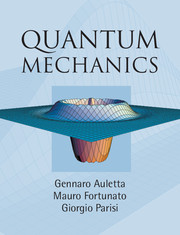Book contents
- Frontmatter
- Contents
- List of figures
- List of tables
- List of definitions, principles, etc.
- List of boxes
- List of symbols
- List of abbreviations
- Introduction
- Part I Basic features of quantum mechanics
- Part II More advanced topics
- Part III Matter and light
- 10 Perturbations and approximation methods
- 11 Hydrogen and helium atoms
- 12 Hydrogen molecularion
- 13 Quantum optics
- Part IV Quantum information: state and correlations
- Bibliography
- Author index
- Subject index
10 - Perturbations and approximation methods
Published online by Cambridge University Press: 05 June 2012
- Frontmatter
- Contents
- List of figures
- List of tables
- List of definitions, principles, etc.
- List of boxes
- List of symbols
- List of abbreviations
- Introduction
- Part I Basic features of quantum mechanics
- Part II More advanced topics
- Part III Matter and light
- 10 Perturbations and approximation methods
- 11 Hydrogen and helium atoms
- 12 Hydrogen molecularion
- 13 Quantum optics
- Part IV Quantum information: state and correlations
- Bibliography
- Author index
- Subject index
Summary
In this chapter, we present some fundamental issues about approximation methods that are often used when a quantum-mechanical system is perturbed and about the relationship between classical and quantum mechanics. In Sec. 10.1 we introduce the stationary perturbation theory, while Sec. 10.2 is devoted to time-dependent perturbations. In Sec. 10.3 we briefly examine the adiabatic theorem. In Sec. 10.4 we introduce the variation method, an approximation method that is not based on perturbation theory. In Sec. 10.5 we discuss the classical limit of the quantum-mechanical equations, whereas in Sec. 10.6 we deal with the semiclassical approximation, in particular the WKB method. On the basis of the previous approximation methods in Sec. 10.7 we present scattering theory. Finally, in Sec. 10.8 we treat a method that has a wide range of applications: the path-integral method.
Stationary perturbation theory
Perturbation theory is a rather general approximation method that may be applied when a small additional force (the perturbation) acts on a system (the unperturbed system), whose quantum dynamics is fully known. If the disturbance is small, it modifies both the energy levels and the stationary states. This allows us to make an expansion in power series of a perturbation parameter, which is assumed to be small. Perturbation theory may be applied both to the case where the additional force is time-independent (in which case a stationary treatment suffices – the subject of the present section) as well as to the case where it explicitly depends on time.
- Type
- Chapter
- Information
- Quantum Mechanics , pp. 357 - 400Publisher: Cambridge University PressPrint publication year: 2009



